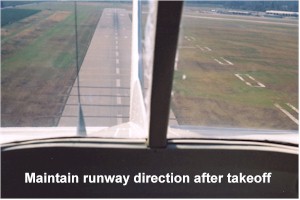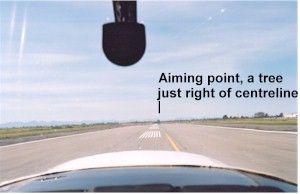 |
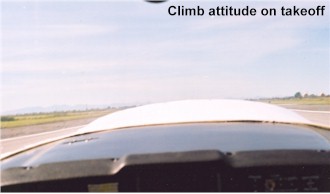 |
The takeoff is one of the easier exercises in a Cessna 152. In this lesson we'll look at four methods by which a Cessna 152 becomes airborne and these are as follows: Normal, Short Field, Soft Field, and Crosswind.
 |
 |
Normal
In the Pilot's Operating Handbook the Normal Takeoff is written as follows:
1. Wing flaps -- 0° - 10°
2. Carburetor heat -- COLD
3. Throttle -- FULL OPEN
4. Elevator control -- LIFT NOSE WHEEL at 50 KIAS
5. Climb speed -- 65-75 KIAS
The way I teach this is slightly different... I don't use
flaps for the Normal Takeoff so we'll leave the flaps up (0°).
The aeroplane is now lined up with the runway centreline and a
point beyond the end of the runway is selected as an aiming
point.
When the throttle is opened the slipstream will spiral around the
fuselage and cause the aeroplane to swing to the left (in no
wind), the aiming point enables us to detect this swing and
therefore stay on the centreline as we accelerate to takeoff
speed. Aim the nose at a distant object, could be a tree!, as you
would a rifle.
If you lift the nosewheel off as soon as practical, this will
help you to avoid nosewheel shimmy where the spinning wheel
wobbles unpleasantly. I say that the elevator is there for the
protection of the nosewheel so keep the weight off it as much as
is possible.
We are looking for a nose attitude that is slightly below the
climb attitude, if we maintain this attitude the aeroplane will
lift off so gently your passenger will not notice that you are
airborne. As the aeroplane accelerates the elevator will become
more and more effective so be prepared to move the control column
forwards to maintain the nose attitude. A common mistake is
allowing the nose to rise and lifting off too early.
Likewise the rudder becomes more effective as the airspeed
increases, and so you'll find that you need less and less right
rudder, but in this case you are aiming at your aiming point
beyond the end of the runway aren't you?
This is the time when the engine is working very hard so it's a
very good time to ensure that the RPM (power), oil pressure and
oil temperature are where they should be. If any of these are out
of limits, reject the takeoff if runway length allows.
I took off in a Cessna 150 (G BFOG) on its first flight in
England, the oil pressure dropped and its temperature rose as I
climbed out. Needless to say I put the aeroplane back down tout
de suite!
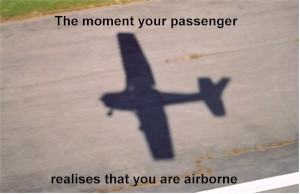
Short Field
Here is the Cessna POH procedure:
1. Wing Flaps -- 10º
2. Carburetor Heat -- COLD
3. Brakes -- APPLY
4. Throttle -- FULL OPEN
5. Mixture -- RICH (above 3000 feet, LEAN to obtain maximum RPM)
6. Brakes -- RELEASE
7. Elevator Control -- SLIGHTLY TAIL LOW
8. Climb Speed -- 54 KIAS (until all obstacles are cleared)
9. Wing Flaps -- RETRACT slowly after reaching 60 KIAS
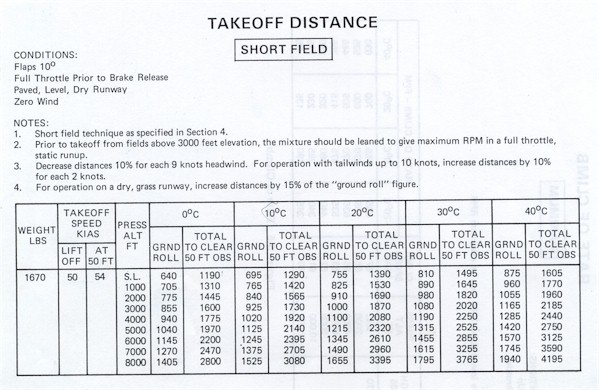
The most important item to consider for the Short Field
takeoff is the takeoff distance available and the surface
condition, ensure you check the TAKEOFF DISTANCE chart in the POH
and apply the corrections as required by the "NOTES".
Once you know roughly how much distance you will need, pace the
field to ensure that it is long enough and pick a "GO/NO
GO" position. If at the GO/NO GO decision point you are not
airborne or at the estimated airspeed you should have, close the
throttle and stop. The GO/NO GO point should have sufficient
'stopway' before you hit an obstruction.
Line up and pick your aiming point, apply full power and confirm
this with the RPM, oil pressure, and temperature gauges. In cold
and damp conditions I like to see the Carburettor Heat -- ON
until about 1500 RPM and then OFF as the power is increased, this
ensures that you have a carb' free of ice.
On brake release the aeroplane will swing a bit more than you
will have been used to and the elevator will be effective
earlier, raise the nose only until you feel the nosewheel clear
the ground. Accelerate to 50 KIAS, and 'rotate' into the climb
attitude.
54 KIAS is the Best Angle of climb speed with 10º Flap, with no
flap use 55 KIAS, when the obstacle is cleared lower the nose and
accelerate to 67 KIAS, but don't retract the flaps until you are
200 feet above ground level.
Soft Field
It's the nature of most soft fields that they are also short!, do a field inspection on foot (wear your wellies!), note the surface condition and select the best track. When the field is both short and soft you really have to use your own judgement, and make sure you have a GO/NO GO decision point, I had to do this for real in a Cessna 150 once... more later.
Set the aeroplane up with 10º Flap. This takeoff begins where you are sitting right now! Apply sufficient power to get the aeroplane moving and keep it moving, don't stop. The control column should be all the way back, we really have to keep the weight off the nosewheel. Apply full power as you line up with your takeoff track, you should have established an aiming point during your field inspection... The control column is held back until the nose rises to the Climb attitude, the objective here is to reduce the weight on the mainwheels as soon as possible, make your decision at the GO/NO GO point whether to fly or to stop straight ahead.
| The short field and soft field takeoff require two different attitudes. To the right the nose wheel is on the ground; the nose is as you might see it prior to opening the throttle for takeoff. |
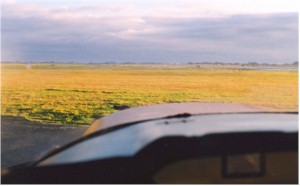 |
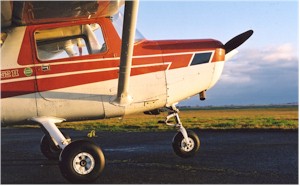 The nose wheel is just clear of the ground. |
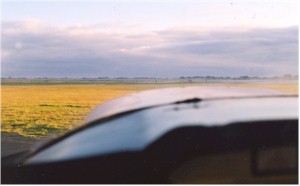 This is the attitude for a short field takeoff. |
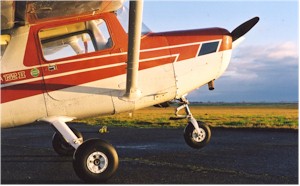 The nose is raised to achieve an angle of attack.. |
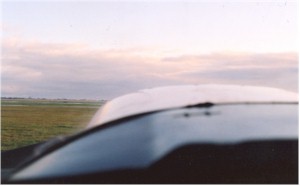 that maximises lift early for a soft field takeoff. |
Click here to see my report on a takeoff from a soft field in a Cessna 150.
Crosswind
A crosswind will always try to take you
sideways off a runway, but there is a way to takeoff and still
maintain runway direction.
A crosswind will either work with or against the natural swing
due to the slipstream. A crosswind from the right may even stop a
swing completely, or cause the aeroplane to swing to the right
(you'll need LEFT rudder!).
Since the wings are set at a DIHEDRAL angle, the into wind wing
will develop more lift than the downwind wing, the aeroplane
believes it is slipping and so tries to right itself (this is the
purpose of dihedral). To ensure that the wing does not rise, use
into wind aileron (rotate the control column in the direction of
the wind).
On takeoff use the short field technique of raising the nose
wheel just clear of the ground, accelerate to 55 KIAS and make a
clean break with the ground. Turn slightly into the wind and
climb out while maintaining runway direction (track).
